
| Granny's Cloak Moth (previously known as Sericia spectans) CATOCALINI, EREBINAE, EREBIDAE, NOCTUOIDEA | (donherbisonevans@yahoo.com) and Stella Crossley & Paul Shaw |
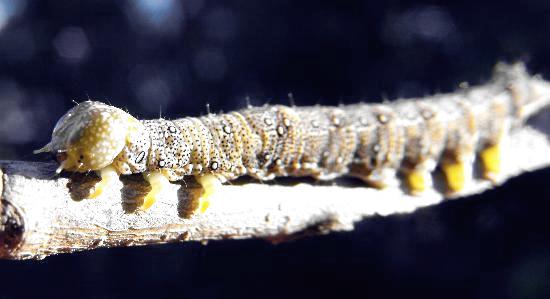
(Photo: courtesy of Martin Bennett, Brisbane, Queensland)

| Granny's Cloak Moth (previously known as Sericia spectans) CATOCALINI, EREBINAE, EREBIDAE, NOCTUOIDEA | (donherbisonevans@yahoo.com) and Stella Crossley & Paul Shaw |

(Photo: courtesy of Martin Bennett, Brisbane, Queensland)
These caterpillars are smooth and pale brown, and covered in black dots. They have several black-edged white spots on each segment, the ones on the last abdominal segment being raised. The head is covered in white dots. The legs and prolegs are pale yellow.

The caterpillars have been found feeding on:
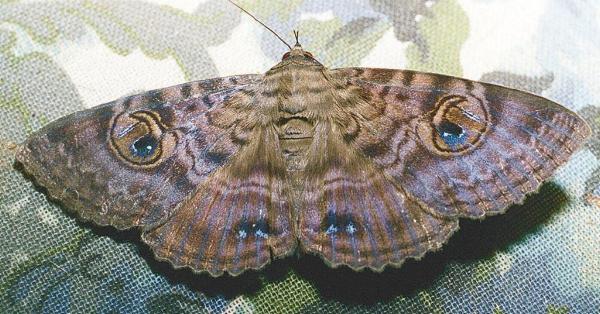
The moth of this species likes to hide in a dark place during the day and frequently is found in sheds and garages. The adult moth has brown wings with zig-zag patterns all over. The wing scales appear to have a finely grooved pattern that diffracts light to give the appearance of different colours depending on the angle of view. On each wing there is a pronounced eye spot, complete with eyelid!
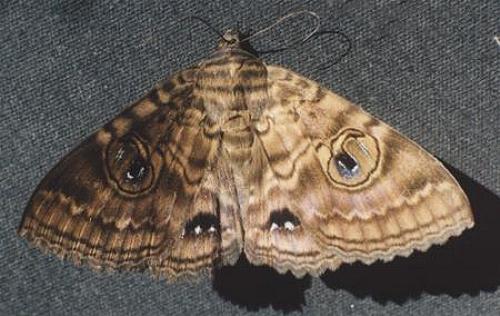
Alternatively, if the spots on the forewings are imagined to be eyes, then those on the hind wings might be thought of as the nostrils of some large reptile. The moths even show a human-like face if viewed upside-down.
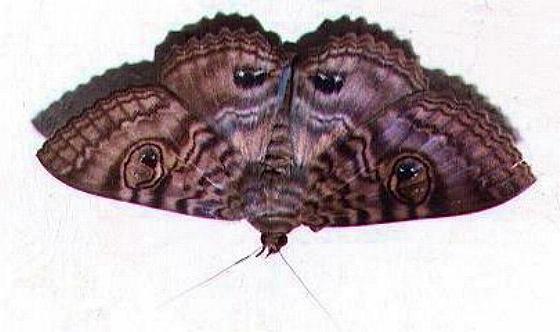
Either way, the appearance may deter possible predators. The moth has a wingspan of about 7 cms.
The adult moths are quite gregarious and seem to like resting in groups of at least a dozen or so. Pheromones probably are involved in this grouping behaviour, but also individuals that hatch on the same host plant (whatever it may be) at the same time would be subject to the same stimuli (light, plant odours etc) and therefore would move together in response, although moths of this size could travel many kilometres so this idea might not be deserving of too much credence.
However, once they find a place where they are secure they don't seem to travel very far in the subsequent days, so maybe they do not generally fly very far at all. When they rest in groups: all the individuals tend to orient themselves in the same direction. If they are on a wall they are head-up near the ceiling (or eaves of the roof) and they hold their wings so that the patterns have maximum impact if approached from slightly below - the direction from which a bird would approach.
The moths also favour dark places such as caves, to rest during daylight hours, but suffer predation by bats in these places.
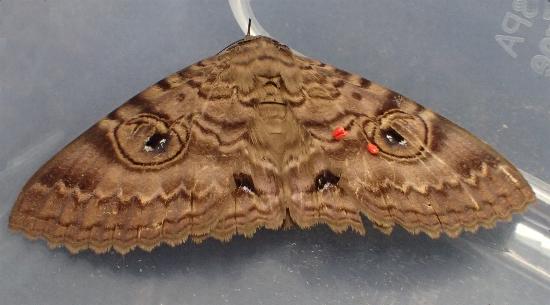
The moths can also be attacked by blood-sucking mites.
The species occurs over much of Australia, including:
Further reading :
Ian F.B. Common,
Moths of Australia,
Melbourne University Press, 1990, fig. 46.1, pp. 43, 55, 451.
Achille Guenée,
Ommatophoridae,
in Boisduval & Guenée : Histoire naturelle des insectes; spécies général des lépidoptères,
Volume 7 (1852), p. 173, No. 1563.
Peter Hendry & John Moss,
Life history notes on the moth Gonodontis luteola
(Turner, 1904) (Lepidoptera : Geometridae) and
Speiredonia spectans (Guenée, 1852) (Lepidoptera : Noctuidae),
Butterflies and Other Invertebrates Club,
Metamorphosis Australia,
Issue 61 (June 2011), pp. 10-13.
Peter Marriott,
Moths of Victoria - Part 8,
Night Moths and Allies - NOCTUOIDEA(B),
Entomological Society of Victoria, 2017, pp. 18-19.
Buck Richardson,
Tropical Queensland Wildlife from Dusk to Dawn Science and Art,
LeapFrogOz, Kuranda, 2015, p. 152.
Paul Zborowski and Ted Edwards,
A Guide to Australian Moths,
CSIRO Publishing, 2007, p. 193.
 caterpillar |  butterflies |  Lepidoptera |  moths |  caterpillar |
(updated 3 January 2013, 10 May 2025)